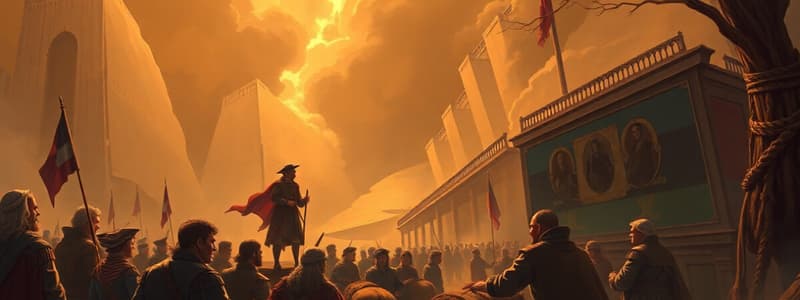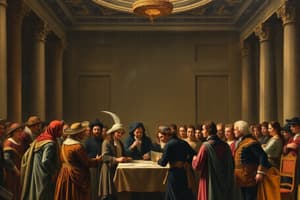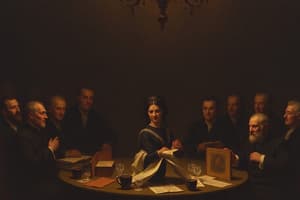Podcast
Questions and Answers
What was the main reason for the creation of the Articles of Confederation?
What was the main reason for the creation of the Articles of Confederation?
- To solidify the colonies' dependence on Great Britain
- To create a separate state for each colony with no central government
- To create a loose union of states with limited central authority (correct)
- To establish a strong central government with broad powers
The Articles of Confederation were written in 1781.
The Articles of Confederation were written in 1781.
False (B)
What was the primary role of the Articles of Confederation?
What was the primary role of the Articles of Confederation?
The Articles of Confederation served as the first constitution of the United States.
The Articles of Confederation were written by representatives of the American colonies who made up the ______ Congress.
The Articles of Confederation were written by representatives of the American colonies who made up the ______ Congress.
Match the following events with their corresponding years:
Match the following events with their corresponding years:
Which of the following was NOT a question facing the newly independent American colonies?
Which of the following was NOT a question facing the newly independent American colonies?
What were some of the major challenges the newly formed United States faced after the American Revolution?
What were some of the major challenges the newly formed United States faced after the American Revolution?
The Articles of Confederation were a success in solving all the problems faced by the newly independent United States.
The Articles of Confederation were a success in solving all the problems faced by the newly independent United States.
Which state did not send any delegates to the Constitutional Convention?
Which state did not send any delegates to the Constitutional Convention?
The United States Constitution was developed in 87 days.
The United States Constitution was developed in 87 days.
What was the purpose of the Constitutional Convention?
What was the purpose of the Constitutional Convention?
What position did George Washington hold after serving as President?
What position did George Washington hold after serving as President?
The ______ was a compromise that addressed the issue of state representation in Congress.
The ______ was a compromise that addressed the issue of state representation in Congress.
George Washington's presidency was marked by a period of peace and stability, with no major conflicts or challenges.
George Washington's presidency was marked by a period of peace and stability, with no major conflicts or challenges.
Which option reflects the Great Compromise regarding state representation in Congress?
Which option reflects the Great Compromise regarding state representation in Congress?
Match the following terms with their corresponding descriptions:
Match the following terms with their corresponding descriptions:
What significant event occurred on December 14, 1799?
What significant event occurred on December 14, 1799?
What is the supreme law of the land in the United States?
What is the supreme law of the land in the United States?
George Washington served two terms as President, from ______ to ______.
George Washington served two terms as President, from ______ to ______.
The delegates at the Constitutional Convention agreed to count enslaved people as part of a state's population for the purpose of representation in Congress.
The delegates at the Constitutional Convention agreed to count enslaved people as part of a state's population for the purpose of representation in Congress.
Match the following actions with their descriptions:
Match the following actions with their descriptions:
What was the primary reason Benjamin Banneker was appointed to lay out the boundaries of the District of Columbia?
What was the primary reason Benjamin Banneker was appointed to lay out the boundaries of the District of Columbia?
Benjamin Banneker was a self-taught mathematician and astronomer who made significant contributions to the development of the new nation.
Benjamin Banneker was a self-taught mathematician and astronomer who made significant contributions to the development of the new nation.
Describe one of the key skills that Benjamin Banneker possessed that made him suitable for his role in laying out the boundaries of the District of Columbia.
Describe one of the key skills that Benjamin Banneker possessed that made him suitable for his role in laying out the boundaries of the District of Columbia.
What was the primary reason why many people considered Thomas Jefferson to be a strong advocate for democracy, equality, and freedom?
What was the primary reason why many people considered Thomas Jefferson to be a strong advocate for democracy, equality, and freedom?
The Louisiana Purchase was the largest single land acquisition in US history.
The Louisiana Purchase was the largest single land acquisition in US history.
What was the primary objective of the Lewis and Clark Expedition?
What was the primary objective of the Lewis and Clark Expedition?
The Louisiana Purchase extended from the ______ River to the ______ Mountains.
The Louisiana Purchase extended from the ______ River to the ______ Mountains.
Match the figures with their role in the events described:
Match the figures with their role in the events described:
Why did the 1800 Presidential Election require the House of Representatives to decide the winner?
Why did the 1800 Presidential Election require the House of Representatives to decide the winner?
The Lewis and Clark Expedition lasted for two years, traveling from the Mississippi River to the Pacific Ocean and back.
The Lewis and Clark Expedition lasted for two years, traveling from the Mississippi River to the Pacific Ocean and back.
What was the name given to the group of explorers involved in the Lewis and Clark Expedition?
What was the name given to the group of explorers involved in the Lewis and Clark Expedition?
What was the proposed compromise to determine a state's population for representation?
What was the proposed compromise to determine a state's population for representation?
The Constitution was immediately ratified by all 13 states.
The Constitution was immediately ratified by all 13 states.
What were the two main points of debate during the Constitutional Convention?
What were the two main points of debate during the Constitutional Convention?
The idea of counting each slave as three-fifths of a person is known as the ______ compromise.
The idea of counting each slave as three-fifths of a person is known as the ______ compromise.
Match the following individuals with their stance on signing the Constitution:
Match the following individuals with their stance on signing the Constitution:
Which of these options were NOT concerns raised by those who did not sign the Constitution?
Which of these options were NOT concerns raised by those who did not sign the Constitution?
The Great Compromise addressed concerns about state representation in the new government.
The Great Compromise addressed concerns about state representation in the new government.
How many states were required to ratify the Constitution before it went into effect?
How many states were required to ratify the Constitution before it went into effect?
Which of the following presidents oversaw the emergence of the two-party system in the United States?
Which of the following presidents oversaw the emergence of the two-party system in the United States?
The Louisiana Purchase, which doubled the size of the United States, occurred under the presidency of James Madison.
The Louisiana Purchase, which doubled the size of the United States, occurred under the presidency of James Madison.
Which president issued the Monroe Doctrine, a significant policy that declared European powers should not interfere in the Western Hemisphere?
Which president issued the Monroe Doctrine, a significant policy that declared European powers should not interfere in the Western Hemisphere?
The development of the national capital, Washington, D.C., was aided by the contributions of ______, a prominent mathematician and surveyor.
The development of the national capital, Washington, D.C., was aided by the contributions of ______, a prominent mathematician and surveyor.
Match the following events to their corresponding presidents:
Match the following events to their corresponding presidents:
Which president oversaw the War of 1812, a conflict that ultimately increased respect for the United States on the international stage?
Which president oversaw the War of 1812, a conflict that ultimately increased respect for the United States on the international stage?
The Bill of Rights, a set of amendments to the United States Constitution guaranteeing fundamental rights and freedoms, was added during the presidency of George Washington.
The Bill of Rights, a set of amendments to the United States Constitution guaranteeing fundamental rights and freedoms, was added during the presidency of George Washington.
Which president is credited with overseeing the addition of the Bill of Rights to the United States Constitution?
Which president is credited with overseeing the addition of the Bill of Rights to the United States Constitution?
Flashcards
Articles of Confederation
Articles of Confederation
The first constitution of the United States, drafted 1776-77.
Second Continental Congress
Second Continental Congress
Meeting of delegates from the 13 colonies to plan governance.
Date of effect
Date of effect
The Articles of Confederation went into effect on March 1, 1781.
Main questions after revolution
Main questions after revolution
Signup and view all the flashcards
Strengths of the Articles
Strengths of the Articles
Signup and view all the flashcards
Weaknesses of the Articles
Weaknesses of the Articles
Signup and view all the flashcards
Independence Declaration
Independence Declaration
Signup and view all the flashcards
Outcome of the Articles
Outcome of the Articles
Signup and view all the flashcards
George Washington
George Washington
Signup and view all the flashcards
Constitution of the United States
Constitution of the United States
Signup and view all the flashcards
Constitutional Convention
Constitutional Convention
Signup and view all the flashcards
Great Compromise
Great Compromise
Signup and view all the flashcards
House of Representatives
House of Representatives
Signup and view all the flashcards
Senate
Senate
Signup and view all the flashcards
Compromise on Slavery
Compromise on Slavery
Signup and view all the flashcards
Three-Fifths Compromise
Three-Fifths Compromise
Signup and view all the flashcards
Ratification
Ratification
Signup and view all the flashcards
Ratification Requirement
Ratification Requirement
Signup and view all the flashcards
Signing Date
Signing Date
Signup and view all the flashcards
Delegates Who Didn't Sign
Delegates Who Didn't Sign
Signup and view all the flashcards
Franklin's Allegory
Franklin's Allegory
Signup and view all the flashcards
Power of National Government
Power of National Government
Signup and view all the flashcards
First Five Presidents
First Five Presidents
Signup and view all the flashcards
Two Party System
Two Party System
Signup and view all the flashcards
Louisiana Purchase
Louisiana Purchase
Signup and view all the flashcards
Monroe Doctrine
Monroe Doctrine
Signup and view all the flashcards
National Capital Development
National Capital Development
Signup and view all the flashcards
War of 1812 Impact
War of 1812 Impact
Signup and view all the flashcards
Bill of Rights
Bill of Rights
Signup and view all the flashcards
Campaign Activity
Campaign Activity
Signup and view all the flashcards
Thomas Jefferson's Beliefs
Thomas Jefferson's Beliefs
Signup and view all the flashcards
Election of 1800
Election of 1800
Signup and view all the flashcards
Impact of the Louisiana Purchase
Impact of the Louisiana Purchase
Signup and view all the flashcards
Lewis and Clark Expedition
Lewis and Clark Expedition
Signup and view all the flashcards
Expedition Length
Expedition Length
Signup and view all the flashcards
Meriwether Lewis and William Clark
Meriwether Lewis and William Clark
Signup and view all the flashcards
Geographical Scope of Louisiana Purchase
Geographical Scope of Louisiana Purchase
Signup and view all the flashcards
Washington's Presidential Cabinet
Washington's Presidential Cabinet
Signup and view all the flashcards
Neutrality Proclamation
Neutrality Proclamation
Signup and view all the flashcards
Benjamin Banneker
Benjamin Banneker
Signup and view all the flashcards
First Census
First Census
Signup and view all the flashcards
Washington's Retirement
Washington's Retirement
Signup and view all the flashcards
Construction of the Nation’s Capital
Construction of the Nation’s Capital
Signup and view all the flashcards
George Washington's Death
George Washington's Death
Signup and view all the flashcards
Study Notes
Overview of the First Five Presidents
- The first five presidents of the United States were influential figures in shaping the nation's early development and policies.
George Washington (1789-1797)
- Unanimously elected as the first president of the United States.
- Established a presidential cabinet, a group of advisors.
- Appointed the first Supreme Court.
- Supported the first census.
- Ratified the Bill of Rights in 1791.
- Set the precedent of presidential neutrality during conflicts between France and Britain.
John Adams (1797-1801)
- The second president of the United States.
- Followed Washington as president.
- Served the first chief executive to live in the White House.
- Followed his own principles in office instead of following others' opinions.
- The United States government moved from Philadelphia to Washington, D.C. during his administration.
- Faced challenges in his role as president due to disputes between France and the United States.
- Avoided war when the French expected the United States to support their war against Britain
- Lost to Jefferson in the 1800 presidential election.
Thomas Jefferson (1801-1809)
- The third president of the United States.
- Author of the Declaration of Independence.
- His two-party system was formed during his administration.
- Bought Louisiana from France in 1803.
- Led the Lewis and Clark Expedition to explore the newly acquired land west of the Mississippi River.
- His main focus was on democracy, equality, and freedom.
James Madison (1809-1817)
- The fourth president of the United States.
- He played a significant role as a delegate in the Constitutional Convention of 1787.
- Was the Father of the Constitution
- Helped to establish the fundamental components of the U.S constitution
- Led the country during the War of 1812.
- Helped create the Supreme Court
- He helped create the U.S. federal system, which divides power between the federal government and the states.
James Monroe (1817-1825)
- The fifth president of the United States.
- Served for two terms as president.
- Served as the secretary of state and secretary of war at the same time during the War of 1812.
- Known for his service in the Virginia Assembly and in the Congress of the Confederation
- Announced the famous Monroe Doctrine warning the Europeans not to interfere with the Western Hemisphere.
- His presidency happened during a period known as "the era of good feeling"
- Faced challenges as president because of the growing conflict over slavery.
Studying That Suits You
Use AI to generate personalized quizzes and flashcards to suit your learning preferences.




